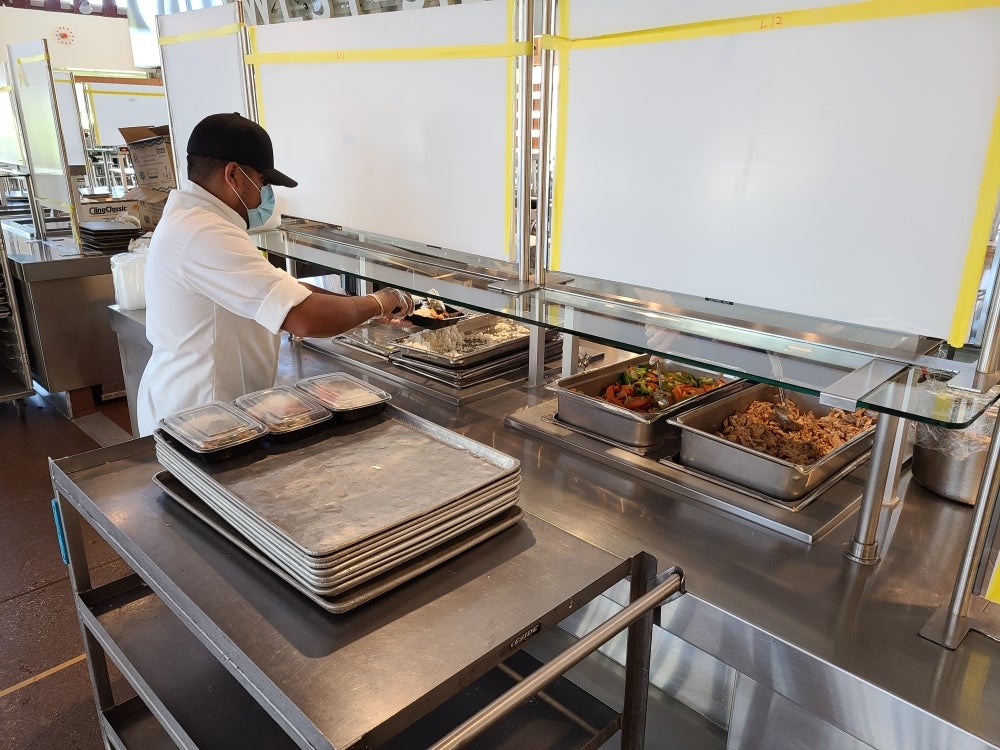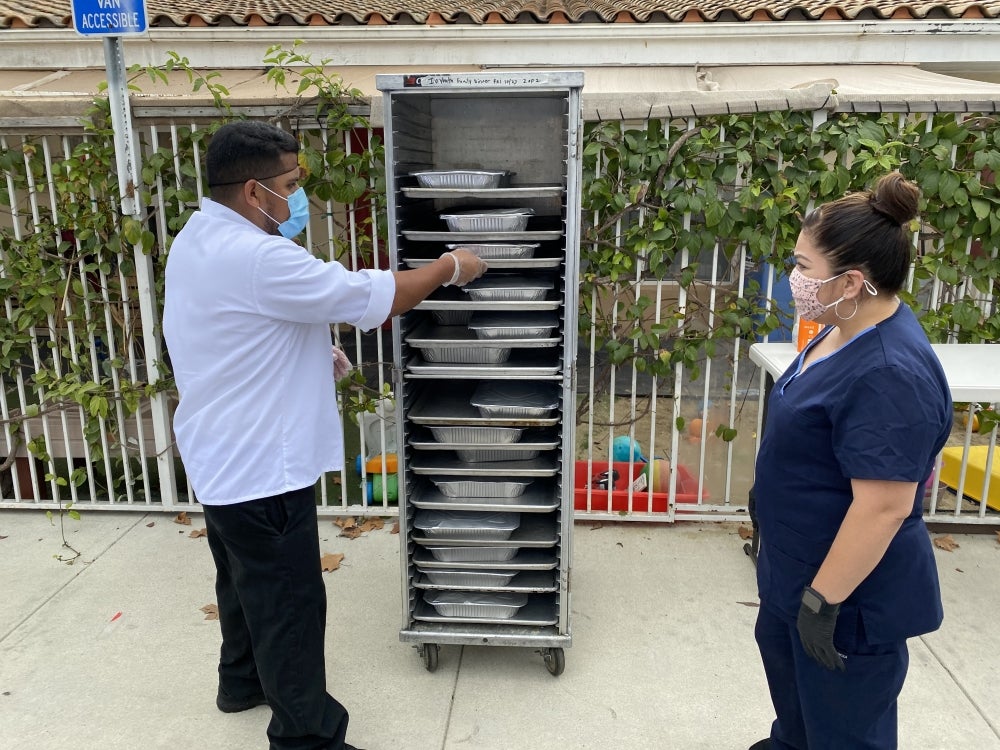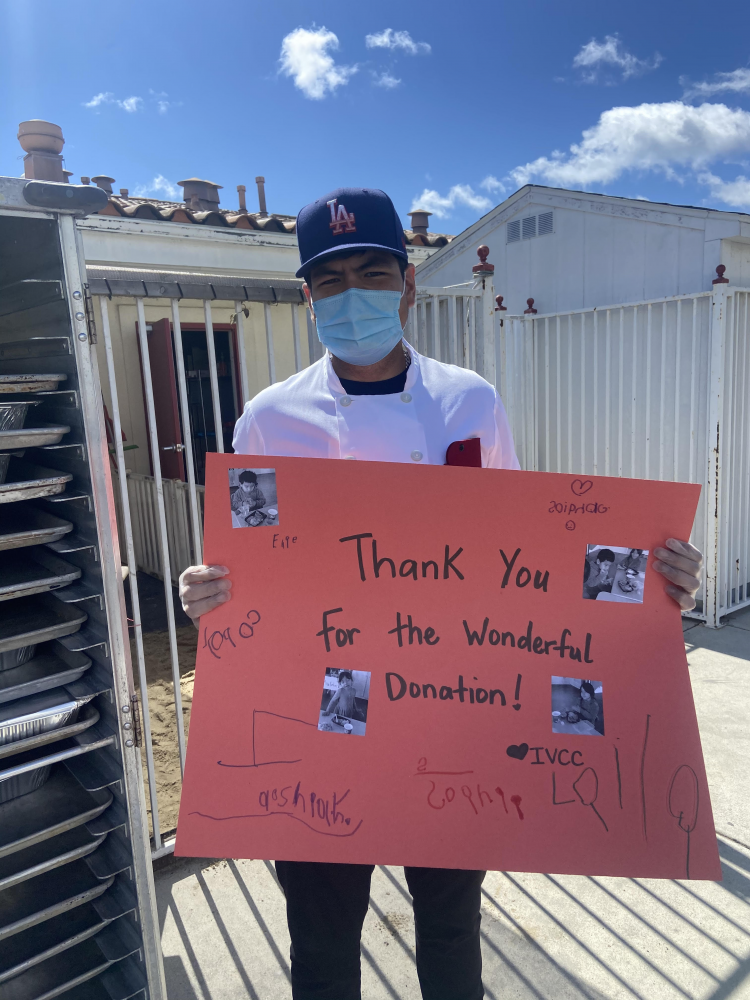Feeding Families, Nurturing Community
In normal times, and for years, Isla Vista Youth Projects (IVYP) has distributed healthy food to community families and college students, supporting some 100-150 individuals each month. These are not normal times.
When the COVID-19 pandemic stormed in, forcing schools and businesses to shut down — and requiring all but essential workers to essentially stay shut in — the need for food increased dramatically among vulnerable populations. Suddenly IVYP, a nonprofit that provides educational, recreational and social programs for children and families regardless of income, was distributing food to 400 people each week.
“The strain on our staff to distribute food in this way has been tremendous,” said Lori Lander Goodman, IVYP’s executive director.
An innovative initiative of UC Santa Barbara and the Community Environmental Council (CEC) helped to ease that strain at its most acute stage. The university’s Campus Dining Services and CEC’s Santa Barbara County Food Rescue Program over the 2020-2021 academic year partnered to provide up to 8,500 prepared meals every week for distribution by IVYP and several other local agencies to food insecure community members, including children, families, seniors and homeless.
In total, Campus Dining prepared and delivered 263,003 meals to 15 local community agencies over a 9-month period from Oct. 2020 through July 2021. The program was funded by donations from multiple UC Santa Barbara Foundation trustees and foundations.
“At a time marked by distance and isolation due to the pandemic, we are immensely grateful that our UC Santa Barbara colleagues, especially those in Campus Dining, and our campus supporters banded together, in collaboration with local nonprofit agencies, to generously support our most vulnerable community members with such a basic necessity as food,” said Chancellor Henry T. Yang. “It is heartwarming to reflect on the fact that during a season when many of us weren't gathering around tables together, this initiative allowed our campus and the Santa Barbara community to continue to share meals with those in need. We are proud to be part of a campus family and a local community that is responsive to the needs of our society, and we are committed to continuing to foster a culture of compassion, service and social responsibility.”
Sparked by a similar effort at UCLA, the UC Santa Barbara initiative was conceived and underway in about two weeks’ time in fall 2020. Once donor funding was secured, CEC’s SBC Food Rescue Program used their network of contacts to quickly connect organizations in need with UCSB Dining.
Generous seed gifts from Doug Troxel of the Change Happens Foundation and alumni Claudia (’75) and Alec (’76) Webster launched the UCSB-Community Food Security Initiative, as it came to be called. Additional private support from Deanna and Jim Dehlsen, and other trustees and friends, helped increase production from 5,000 to 7,500 families weekly.
“We witnessed a staggering rise in hunger worldwide due to COVID-19,” said Troxel. “All of us at the Change Happens Foundation were honored to be able to support UCSB’s efforts to provide healthy prepared meals to Santa Barbara County residents struggling with food insecurity and applaud the UCSB culinary staff and local non-profits working together to serve those in need.”
Noted Sigrid Wright, CEO and executive director of CEC, “Last year called on our community to pool its resources and collaborate in creative ways to support the most vulnerable among us. As part of our COVID-19 response efforts, CEC’s SBC Food Rescue learned about the significant need for more prepared meals for charitable distribution, and immediately began partnering with local agencies to identify service gaps and tackle distribution logistics. When UCSB reached out, we saw this as the perfect opportunity to continue leveraging these networks.
“It was an honor to team with UCSB in this effort,” Wright added. “It served those in need and bolstered our local community resilience.”
Indeed, the initiative was a win from every angle. It put dining staff back in campus kitchens, which had gone dark as instruction was conducted online and residence halls sat empty; it bonded the university and local agencies in an effort to help their community; and it and gave everyone involved a renewed sense of purpose.
“Many people have lost a lot due to the pandemic, and that includes food security,” said Jill Horst, executive director of Campus Dining. “It’s so great that we had this opportunity to help the community where the university is located and where our employees live. And this was a huge boost for us as well. Food is what we do — we love preparing nutritious meals and putting smiles on the faces of the people we feed.”
UCSB Residential Dining Services during the 2020-2021 academic year was providing meals to a greatly reduced student population, according to director Ron Varenchik. To best utilize their available time, dining staff were doing extra training and preparation for the eventual return of students — installing plexiglass dividers and decals and other social distancing measures, and developing a COVID training plan for how to work safely when diners come back.
“About 80% of our staff was here, but we only had a small number of customers,” Varenchik said. “We’re used to being extremely busy — normally each unit is serving 3,000-4,000 guests every day and suddenly only one of our units was serving a maximum of 1000 per day. To be able to get our staff back on their feet, doing what they know how to do and knowing it’s all for a good cause was unbelievable. It was a huge morale booster. I can’t even express how much it meant to all of the staff to have such meaningful work.
“It was really rewarding working with this group of people,” he added of CEC and all the local agencies involved. “With COVID everything was flipped on its head, and all these groups were just rolling with the punches of whatever we needed to do to get it done. It’s been a great partnership across the board. It was never, ‘How are we going to do this?’ but just, ‘Let’s do this.’ It was inspiring.”
The program also highlights in stark detail the widespread impact of the pandemic across the Santa Barbara community.
Before COVID times, the Salvation Army in Goleta served roughly 50 families per month at its food pantry. By the fall of 2020, some 186 families per day were visiting the pantry. Of the families then collecting food from Salvation Army, 85% were new to needing assistance, according to Jessyca Carr, at that time a Santa Barbara Corps Officer (now with the Murrieta Corps) in Salvation Army’s California South Division.
“There is a significant need that has arisen,” Carr said back then. “According to our numbers, our distribution has increased 7,000%. I am not exaggerating. These meals came at a perfect time for us.”
Northern Santa Barbara County United Way hand-delivered prepared meals from UC Santa Barbara directly to unsheltered residents — whose numbers increased during the pandemic.
“After COVID hit, many meal shares and volunteer efforts stopped because of safety concerns,” said Emily Allen, former director of the agency’s Homeless and Veterans Impact Initiatives and of Home For Good Santa Barbara County. “While food distribution programs sprang into action, much of the food required a kitchen to prepare. Access to healthy prepared meals became a challenge for our unhoused neighbors. We are grateful to UCSB for providing the prepared food and the Isla Vista Community Service District for providing the space to coordinate the distribution of the food.
“Being able to offer healthy prepared food helped us engage our unhoused neighbors and work on long term solutions like Supportive Housing,” Allen added.
During week one of the initiative, UCSB delivered 3,600 meals in total; by week two they were up to 5,500 meals. By week 5, with the addition of a few more partner agencies, they were serving up to 8,300 meals per week.
The list of agencies that received meals also included La Casa de la Raza; St. Vincent’s; CityNet; Dorothy Jackson Family Resource Center in Lompoc; Family Services Agency; Santa Barbara Unified School District; Goleta Unified School District; and Partners in Caring.
“We are so grateful for the partnership with UCSB,” said IVYP’s Goodman. “It made such a huge difference for so many in our community. By the end IVYP had distributed over 62,000 meals!
“Receiving prepared meals makes life easier for our most vulnerable families,” she added. “I think part of the impact of receiving meals also is that families who receive them feel that the community cares about them. This increases civic engagement and creates a sense of belonging. I don’t think it can be understated how important it is to feel cared for within your community. This meal distribution fed hearts and well as bellies.”






